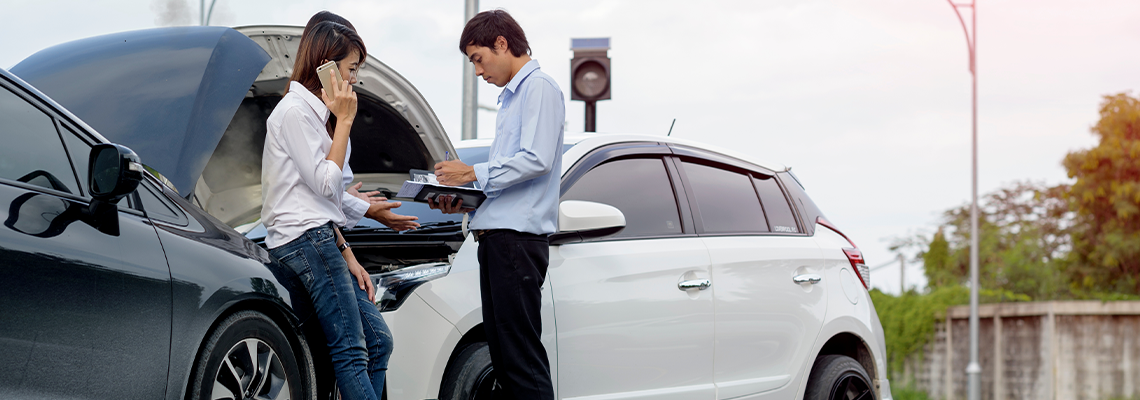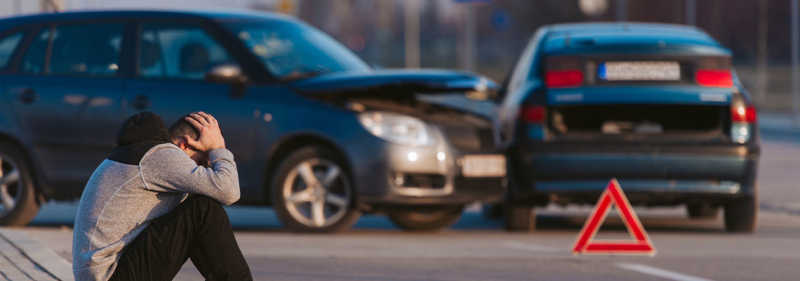
What Evidence Is Crucial for Proving Liability in Car Accident Cases?
Nobody expects a routine drive to turn into a nightmare. One moment, you're cruising down the highway, and the next, screeching tires and shattering glass shatter your sense of safety. The physical pain hits first—the whiplash, the bruises, the cuts that sting with every breath.
A car accident doesn't just damage vehicles; it upends everything, leaving victims to grapple with insurance claims, fault disputes, and the path to justice. It's a raw, isolating experience that demands compassion and action.
At Gama Law Firm LLC, our experienced Colorado car accident attorneys stand ready to guide clients through this upheaval. We serve folks in Denver, Aurora, Parker, Centennial, Castle Pines, and the surrounding Colorado towns, turning overwhelming chaos into a clear strategy for recovery.
When you face the aftermath of a crash, we're here to collect the facts, build your car accident case, and fight for your compensation. Reach out to us today. We’re at the very southeast corner of the Denver Metro Area.
Police Reports and Official Records
Right after a car accident, the police report emerges as a cornerstone piece in establishing who bears responsibility. Officers arrive on scene, assess the damage, interview those involved, and jot down details that capture the moment's essence.
This document isn't just paperwork; it's an impartial snapshot that courts and insurers rely on heavily. For clients reeling from the impact, we emphasize grabbing this report early—it's often available within days and can sway the entire narrative of fault.
Clients benefit immensely when we review these reports with them, highlighting key sections that pinpoint violations such as speeding or failure to yield. Without it, stories from the road can blur into he-said-she-said battles. We've seen how a single citation noted in the report shifts leverage, making insurers think twice before lowballing a settlement.
To make the most of police reports, focus on these critical elements:
Diagram of the scene: Shows vehicle positions, skid marks, and impact points to illustrate how the accident unfolded.
Officer’s narrative: Includes observations on weather, road conditions, and initial statements from drivers and passengers.
Witness contacts: Lists names and details of bystanders who saw the events, providing leads for follow-up.
Traffic citations issued: Notes any tickets for infractions, directly tying actions to negligence.
These components weave together to form a credible baseline, one that we use to anchor stronger arguments later. As clients review their reports with us, patterns emerge—perhaps the at-fault driver's admission of distraction or the clear evidence of running a red light. This isn't about overwhelming details; it's about clarity that empowers decisions.
We've helped countless clients in Aurora and beyond transform these initial documents into compelling evidence packages, smoothing the road to fair outcomes. Moving forward, layering in personal accounts adds the human element that reports alone can't capture.
Eyewitness Accounts
Nothing cuts through ambiguity like someone who saw it all. Eyewitnesses bring the car accident to life, recounting the split-second decisions—or lapses—that led to the crash. Their statements can corroborate the police version or fill in gaps, offering a fresh angle on liability.
At Gama Law Firm LLC, we always advise clients to note down witness details at the scene—names, numbers, even quick descriptions of what they observed. It's a simple act that pays dividends when we later depose them or include their affidavits in filings.
In Colorado courts, these accounts carry weight because they're unfiltered glimpses into truth, often tipping scales in rear-end collisions or intersection mishaps. Gathering effective eyewitness input involves these steps:
Jot down what the witness says right away, including their vantage point and any visible signs of the other driver's impairment.
Exchange info politely, assuring them we'll follow up without pressure.
Schedule chats soon after to record full statements, probing for specifics like speed estimates or signal usage.
Formalize accounts under oath to boost credibility in legal proceedings.
These practices turn fleeting observations into lasting assets. It's the voices that humanize the data, reminding everyone involved of the real stakes.
Eyewitness accounts shine brightest when paired with visuals, but on their own, they humanize the cold facts of a report. We've guided clients through nurturing these connections, verifying that their stories resonate without exaggeration. Working closely and openly with an experienced personal injury attorney can add credibility to your case.
Visual Proof, Photos, and Videos
A picture truly speaks a thousand words, especially when it freezes the chaos of a car accident in time. Photos and videos from the scene document positions, damage, and surroundings in ways words struggle to match.
They reveal truths like obscured signs or debris patterns that suggest reckless maneuvering. For clients still shaken, we encourage snapping shots immediately—before towing services alter the layout.
Colorado's variable weather means conditions like icy patches show up clearly in footage, directly linking them to slips in duty of care. Key ways to leverage visual evidence include:
Scene-wide shots: Capture the overall layout, including lane markers, signals, and nearby obstacles, to contextualize the collision.
Damage close-ups: Detail dents, scratches, and fluid leaks on both vehicles, helping mechanics later trace force directions.
Environmental factors: Photograph weather effects, like rain-slicked roads, or visibility issues from fog or sun glare.
Timestamped videos: Use phone recordings to show sequences, such as the moments leading to impact.
These elements build a visual timeline that's hard to dispute. It's about capturing reality as it was, not as it's spun later.
Linking Injuries to the Crash Through Medical Evidence
Injuries don't shout; they whisper through records and scans, but they scream liability when connected properly to the wreck. Medical documentation proves not just the hurt, but how the accident caused it—essential for showing the other party's negligence led to real suffering.
Clients often overlook this at first, focused on recovery, but we stress documenting every visit from day one. Treatment providers generate these records: bills, diagnoses, and progress notes that map pain's progression.
In Colorado claims, linking whiplash to a rear-end jolt or fractures to side-swipes demands this paper trail. We've seen insurers drag their feet without it, questioning causation to slash payouts. Essential medical proofs encompass:
Initial ER reports: Detail immediate symptoms and treatments, establishing the timeline from crash to care.
Diagnostic imaging: X-rays, MRIs, and CT scans that pinpoint trauma directly attributable to impact forces.
Physician notes: Ongoing entries on pain levels, mobility limits, and therapies prescribed post-accident.
Bills and receipts: Quantify costs, from ambulance rides to follow-ups, underscoring financial fallout.
These records form a bridge from event to effect. It's the quiet accumulator that amplifies a car accident case's urgency.
Medical evidence concludes the personal toll but opens doors to mechanical knowledge. We help clients compile these without hassle, making sure that nothing slips through. As we explore tech data next, the puzzle pieces align even more tightly.
Black Boxes, Surveillance, and Other Technological Data
Modern cars and streets brim with hidden recorders, turning abstract claims into concrete data streams. Event data recorders—those "black boxes"—log speed, braking, and seatbelt use in the crash's final seconds. Traffic cams and dashcams add layers, capturing angles that reports miss. For clients in fast-paced Denver traffic, tapping these sources uncovers hidden truths.
We guide folks to request black box downloads through mechanics or subpoenas, as Colorado law allows access in disputes. Surveillance footage from intersections often reveals red-light runs or distracted scrolling. Harnessing tech evidence requires attention to:
Event data recorder outputs: Speed, throttle, and ABS activation metrics that contradict driver alibis.
Dashcam and phone videos: Continuous feeds from your vehicle or bystander clips synced to timelines.
Traffic camera pulls: City hall requests for feeds covering the crash zone, often free but time-sensitive.
Cell records: Call logs proving distraction, like texting mid-turn.
These digital trails cut through fog. They're the future-proof backups that modern wrecks demand.
Tech data enhances but doesn't eclipse human elements; it verifies them. We've streamlined access for clients across our service areas, demystifying the process. Vehicle exams follow, detailing the physical scars that data implies.
Detailing the Damage With Vehicle Inspections
Skid marks fade, but bent frames and shattered lights endure as silent witnesses. Professional inspections dissect vehicle harm, reconstructing forces at play to assign blame.
Mechanics measure crumples and alignments, revealing if a T-bone hit came from the side or a swerve. Clients appreciate this when insurers downplay "minor" dings that hide severe undercarriage issues.
In Colorado's rugged drives, we push for certified appraisers early—before repairs erase clues. Reports quantify everything from airbag deploys to fluid trajectories, painting liability in metallic terms. Critical inspection findings include:
Structural assessments: Frame bends and suspension shifts indicate collision angles and speeds.
Component failures: Brake wear or tire blowouts tied to maintenance neglect by the at-fault party.
Paint transfers: Traces from one car on another, mapping contact points precisely.
Pre- and post-crash comparisons: Photos highlighting new versus old damage for authenticity.
These analyses solidify narratives. It's the forensic touch that elevates car accident cases. Inspections cap the evidentiary toolkit, synthesizing all prior threads. We coordinate these for clients seamlessly, confirming thoroughness. With this arsenal, liability stands clear, paving the path to recovery.
Take the Next Step and Contact Experienced Attorneys
Piecing together evidence isn't a solo endeavor—it's a collaborative push toward justice that demands persistence and knowledge. From the raw shock of impact to the calculated builds of a car accident case, every document, snapshot, and statement contributes to proving who failed whom.
Clients in Denver, Aurora, Parker, Centennial, Castle Pines, and nearby Colorado towns discover renewed strength when our firm steps in, led by Hon. Joe Richard Gama, Attorney & Superior Court Judge, and Richard Gama, Attorney at Law. Don't let faded memories or stonewalled claims dim your pursuit. Reach out to us at Gama Law Firm LLC today.

